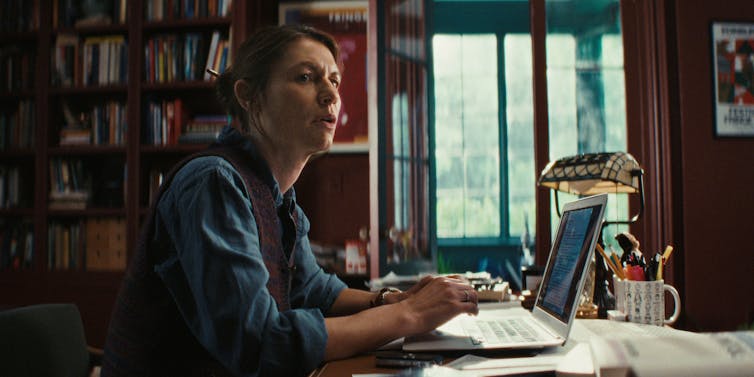- Home
Edition
Africa Australia Brasil Canada Canada (français) España Europe France Global Indonesia New Zealand United Kingdom United States Edition:
Global
Edition:
Global
- Africa
- Australia
- Brasil
- Canada
- Canada (français)
- España
- Europe
- France
- Indonesia
- New Zealand
- United Kingdom
- United States
 Academic rigour, journalistic flair
Academic rigour, journalistic flair
 Netflix
Hit Netflix drama The Beast in Me does wrong by survivors of family violence
Published: November 25, 2025 1.20am GMT
Laura Walls, Queensland University of Technology
Netflix
Hit Netflix drama The Beast in Me does wrong by survivors of family violence
Published: November 25, 2025 1.20am GMT
Laura Walls, Queensland University of Technology
Author
-
 Laura Walls
Laura Walls
PhD Candidate in Screenwriting, Queensland University of Technology
Disclosure statement
Laura Walls does not work for, consult, own shares in or receive funding from any company or organisation that would benefit from this article, and has disclosed no relevant affiliations beyond their academic appointment.
Partners
Queensland University of Technology provides funding as a member of The Conversation AU.
View all partners
DOI
https://doi.org/10.64628/AA.ug6p9n7sm
https://theconversation.com/hit-netflix-drama-the-beast-in-me-does-wrong-by-survivors-of-family-violence-270365 https://theconversation.com/hit-netflix-drama-the-beast-in-me-does-wrong-by-survivors-of-family-violence-270365 Link copied Share articleShare article
Copy link Email Bluesky Facebook WhatsApp Messenger LinkedIn X (Twitter)Print article
In The Beast in Me, Aggie Wiggs (Claire Danes) is a reclusive writer who gets drawn into the world of her new neighbour, Nile Jarvis (Matthew Rhys), a narcissistic and possibly psychopathic businessman. When Aggie begins digging into the suspicious disappearance of Nile’s first wife, Madison (Leila George), their tentative alliance quickly descends into a dangerous game of cat and mouse.
Netflix has given the series a TV-MA rating, which they define as not suitable for ages 14 and under. Given this rating, I was surprised and troubled by a scene in episode seven, directed by Antonio Campos, in which Nile repeatedly and violently bludgeons Madison until she dies.
The sickening thuds are intercut with flashes of artworks hanging on the gallery walls around them, adding to the scene’s theatricality. Afterwards, Jarvis curls up sobbing beside Madison while the camera lingers on her caved-in, barely-recognisable-as-human face.
For a series that deals with such a delicate and complex topic as intimate partner homicide, the scene feels not only gratuitous but tone-deaf: an indicator that showrunner Gabe Rotter does not understand his subject matter or how his female audience might relate to it.
Talking about violence against women
Violence against women is a worldwide epidemic. One in three women experience intimate partner violence at some point during their lifetime. Young men are being radicalised online by misogynist influencers. Porn has become more extreme, with once niche acts like choking seeping into the mainstream.
But rather than offer up any real critique, The Beast in Me depicts its key scene of gender-based violence as titillating, blood-spattered spectacle.
Adolescence (2025) offers an alternative way to approach this heavy subject matter.
Instead of mining the murder of a schoolgirl for cheap thrills, the showrunners focus on the unnervingly normal perpetrator’s mindset and the devastating impact his actions have on his family and community. The murder itself is shown only briefly and from a distance, through CCTV footage. The mundane framing of the attack is what makes it hit so hard.
Through its sensitive portrayal, Adolescence has forced important conversations out into the open about the causes and consequences of gender-based violence and the prevalence and appeal of extreme online content. It’s inspired parents, teachers and community members to educate themselves on how to intervene.
Violence – without the shock
It isn’t clear what purpose the graphic violence in The Beast in Me serves, beyond shock value. It reveals nothing new about Nile (well-established as a psychopathic killer by this point) or the nature of femicide, nor does it add to the plot.
The Beast in Me does have moments where murder is depicted with more restraint. In episode four, directed by Tyne Rafaeli and foreshadowing the later episode, Nile frantically bludgeons FBI agent Brian Abbott (David Lyons) to death.
We don’t see the victim’s face mashed to a pulp. There’s no tragic tableau of death or romanticised artistic cutaways. The camera remains on the perpetrator’s face for the whole attack.
 Matthew Rhys plays Nile, a psychopathic killer.
Chris Saunders/Netflix
Matthew Rhys plays Nile, a psychopathic killer.
Chris Saunders/Netflix
The purpose of the scene isn’t to glamorise murder or shock us with gore. It shows us who this character really is when his mask slips. It’s terrifying, incredibly effective storytelling that’s impossible to look away from.
Conversely, the femicide in episode seven was, for me at least, impossible to watch.
Deconstructing the male gaze
The marked difference with which these two attacks are treated on screen points to the difference between a male gaze and a female one.
First coined by Laura Mulvey in the 1970s, the concept of the male gaze refers to cinematic output in which woman is “spectacle” and man is “the bearer of the look”. It reduces female characters to objects to be fetishised.
Beautiful, willowy, mentally unstable Madison is the quintessential female victim – so when Campos allows his camera to linger tantalisingly on her bloody corpse we’re all forced to view her through that same masculine lens.
But as Rafaeli demonstrates in her episode, we don’t need to see the victim’s blood-soaked body in all its dehumanising, artistically-arranged glory for the scene’s impact to be felt. In fact, we don’t need to see the body at all.
 Claire Danes plays Aggie Wiggs, a reclusive writer who gets drawn into the world of her new neighbour.
Netflix
Claire Danes plays Aggie Wiggs, a reclusive writer who gets drawn into the world of her new neighbour.
Netflix
From Game of Thrones (2011–19) to newer shows like Fallout (2024–) and The Boys (2019–), streamers seem determined to outshock each other, concocting evermore disturbing ways for characters to harm each other.
When the storylines revolve around medieval-style power struggles, exaggerated comic-book worlds or apocalyptic hellscapes, the B-movie horror aesthetic kind of makes sense: it’s what viewers have signed up for and expect.
But does it have a place in a premium drama episode about femicide?
The Beast in Me is a great watch. The lead performances are superb. The tension is expertly built. But the tonal blunder in the penultimate episode exposes Rotter’s fundamental misunderstanding of his subject matter. The creative team have sacrificed sensitive, sophisticated storytelling in return for a schlocky cheap thrill.
Ultimately, filmmakers have a duty of care to their audience as well as the community of people whose experiences they’re representing on screen, in this case survivors of family violence. The Beast in Me shows there’s still much work to be done.
The National Sexual Assault, Family and Domestic Violence Counselling Line – 1800 RESPECT (1800 737 732) – is available 24 hours a day, seven days a week for any Australian who has experienced, or is at risk of, family and domestic violence and/or sexual assault.
- Violence against women
- Netflix
- Screen
- Femicide
Events
Jobs
-
 Analyst, Student Information and Regulatory Reporting
Analyst, Student Information and Regulatory Reporting
-
 Lecturer in Paramedicine
Lecturer in Paramedicine
-
 Associate Lecturer, Social Work
Associate Lecturer, Social Work
-
 Lecturer, Communication Design
Lecturer, Communication Design
-
 Leading Research Centre Coordinator
Leading Research Centre Coordinator
- Editorial Policies
- Community standards
- Republishing guidelines
- Analytics
- Our feeds
- Get newsletter
- Who we are
- Our charter
- Our team
- Partners and funders
- Resource for media
- Contact us
-
-
-
-
Copyright © 2010–2025, The Conversation

 Analyst, Student Information and Regulatory Reporting
Analyst, Student Information and Regulatory Reporting
 Lecturer in Paramedicine
Lecturer in Paramedicine
 Associate Lecturer, Social Work
Associate Lecturer, Social Work
 Lecturer, Communication Design
Lecturer, Communication Design
 Leading Research Centre Coordinator
Leading Research Centre Coordinator


